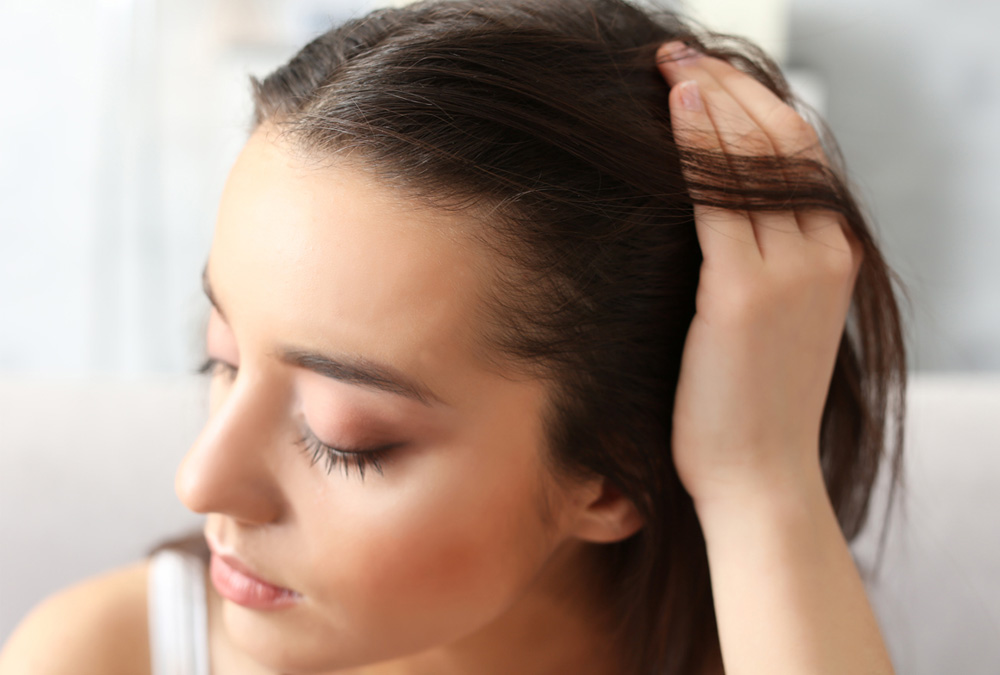Alopecia in women
More and more women are suffering from thinning hair or hair loss. This is a serious problem for many, not only of an aesthetic nature but also psychologically. This can reduce the sense of attractiveness and self-confidence, negatively affect social life and general well-being, and may promote the development of depression. Fortunately, the condition can be remedied in most cases.

The most common causes of hair loss in women
Androgenetic alopecia — It is believed that this genetic predisposition affects about 40% of women suffering from hair loss. The symptoms include a diffuse thinning on the top of the head, but unlike men, this rarely leads to complete alopecia. An additional factor affecting hair loss in women, in addition to excess androgen, is a disturbed proportion of female and male sex hormones.
Alopecia areata — This is an autoimmune disease whose symptoms initially have the form of single balding patches. Over time, they become larger and begin to merge into clusters. In some patients the disease may be recurrent. Treatment is not easy, requiring the use of both oral and topical medications and the care of a dermatologist. Psychological help is also recommended, as the disease is believed to be psychoderma-tological. The treatments applied in our clinic can, however, have a supporting effect and quickly improve the appearance of the hair, and thus the patient’s well-being.
Seasonal hair loss — This is how widespread hair loss in the fall and spring is commonly called, because it is then that the natural rhythm of hair replacement is disturbed, probably due to hormones. In a healthy body, hair never falls out all at once. It is mostly in the growth phase, with some in the phase of decline and some in the phase of loss (about 10%). Full hair replacement is, therefore, imperceptible; it lasts approximately 3 years and repeats on average 25 times throughout life. However, twice a year the so-called synchronization of the telogen phase occurs when a more than normal amount of hair in the growth phase ends its life cycle, goes into the rest phase, and then falls out. You’ll see hair loss due to spring synchronization in the fall, and the fall result in the early spring. This is a temporary condition, but it is worth supporting yourself with the available methods of strengthening the hair and stimulating the hair follicles to activity.
Hormonal alopecia — This can occur after pregnancy or after hormone therapy (e.g., in women who use hormonal contraceptives). Weakness and thinning of the hair can also be accompanied by hypothyroidism. After pregnancy, many women observe their hair thickening, which is in a constant growth phase due to increased production of estrogen. However, during the nursing period there is a sudden drop in estrogen levels and increased prolactin secretion, resulting in excessive hair loss. Another difficult period for maintaining a lush hairstyle, also associated with a decrease in estrogen levels, is menopause. Thinning of the hair then occurs over the entire surface of the head. This process may stop or be mitigated by hormone replacement therapy.
Alopecia due to other factors — The use of certain medications, stress, and a diet low in nutrients, all these can contribute to severe hair loss.
Before you start taking any treatments — although the sooner, the better — you need the right diagnosis and an accurate identification of the causes of this condition. A trichoscopy examination can be useful. It is also extremely important for women to have the hormone, vitamin, and mineral levels in the body tested. Only then will the treatment offered be effective and safe. Also remember that hair loss can be a symptom of systemic diseases, which a doctor can only recognize after careful analysis of many factors.




